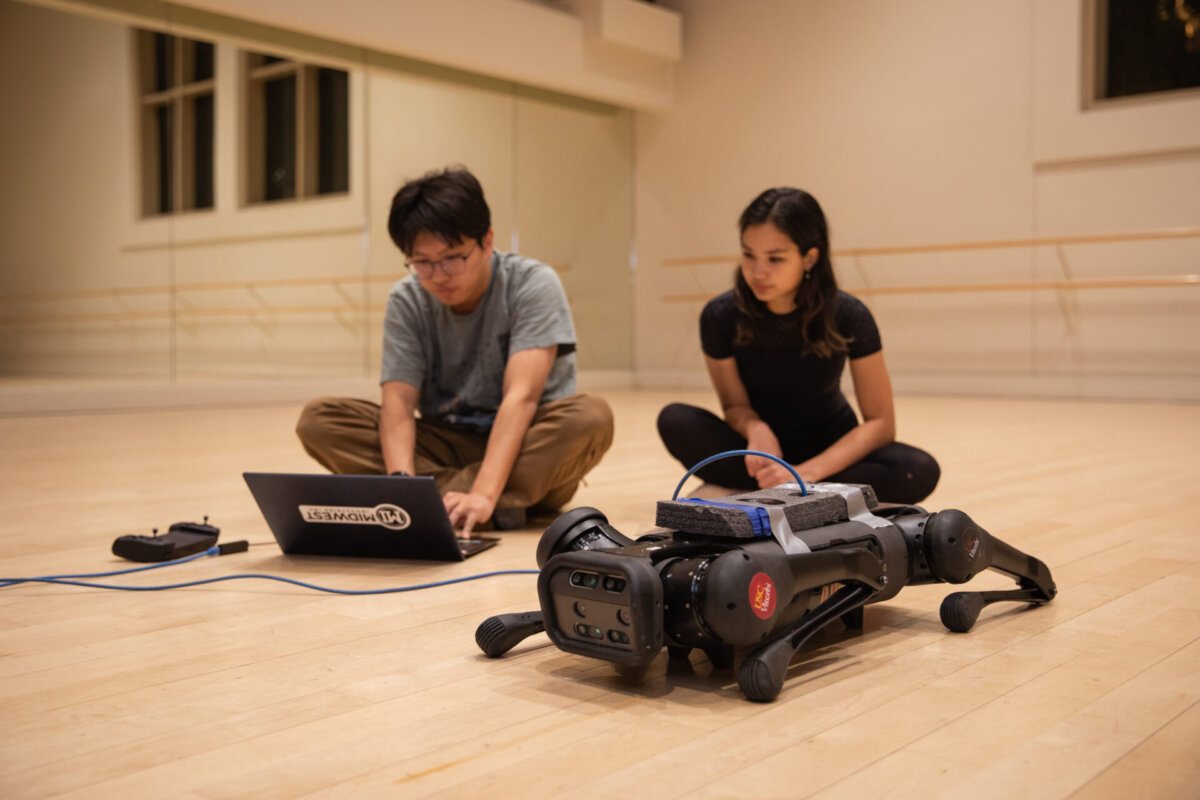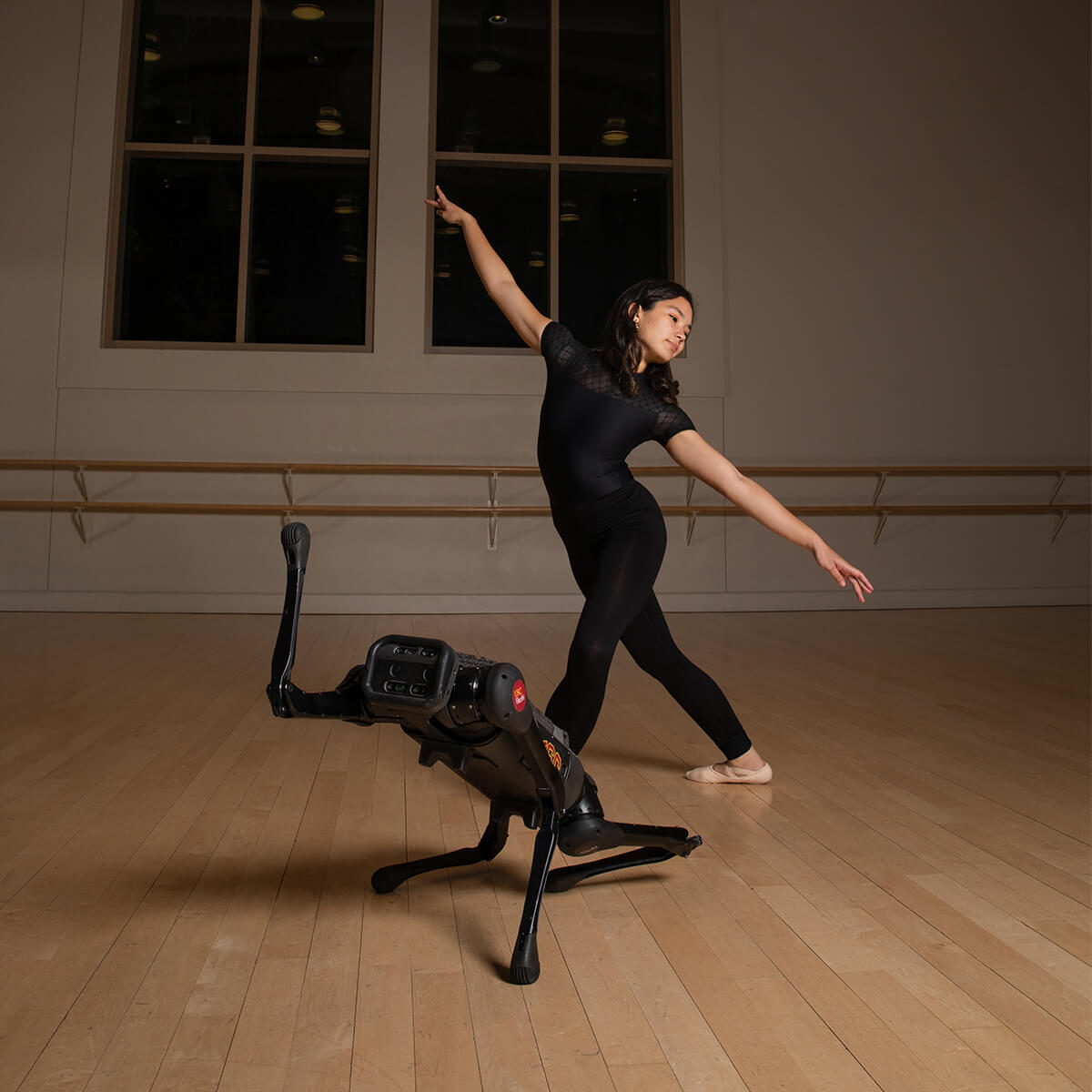This Robot’s Got Rhythm
The robots in Quan Nguyen’s Dynamic Robotics and Control Laboratory have been programmed to move in some pretty sophisticated ways. There’s one that can climb stairs, jump and do backflips on its wheeled legs, and another that can navigate stepping stones of different heights. But for Nguyen, assistant professor of aerospace and mechanical engineering at USC Viterbi, the latest challenge for the lab’s quadruped robot goes beyond locomotion and into the realm of artistic expression.
Can it bust a move?
Nguyen is working with Margo K. Apostolos, a professor in USC’s Glorya Kaufman School of Dance, to explore how to make a four-legged robot dance with rhythm and grace.
“It may help to inspire us to develop a better algorithm for locomotion,” said Nguyen, whose primary research interest is improving robot agility for risky tasks such as firefighting and disaster response.
Art meets science
Apostolos, who helped pioneer the field of robot choreography in the 1980s, approached USC Viterbi Dean Yannis C. Yortsos in June 2021 with a desire to revisit robotics research after a few decades away from it. She was looking for a collaborator, and Yortsos suggested Nguyen. The two hit it off and began a research pas de deux.
Every Thursday, the two professors gather in Nguyen’s lab with a group of dance and engineering students who have volunteered to work together on translating human choreography into robot form, an endeavor Nguyen calls
“choreobotics.”
While Nguyen has his eye on advancing control algorithms and machine learning, Apostolos hopes to broaden the boundaries of dance as an art form. But both also hope to increase acceptance of robots: They believe swapping angular movements for more graceful ones can help humanize them. “In the future, maybe more people will be more willing to work with robots, or to accept robots to help them with a certain scenario,” said Nguyen.

Poetry in motion
Though the lab’s dog-like robot is never going to move in precisely the same ways as a human dancer, the choreobotics group is striving to preserve the essential qualities of motion that any given choreography expresses.
“It’s a really challenging dynamics problem,” said Kaitlyn Kumar, a USC Viterbi junior majoring in mechanical engineering and minoring in dance. She gave the example of an arabesque, a ballet posture in which a dancer stands on one leg with the body bent forward at the hip, extending one arm forward and the other arm and leg backward.
“We can’t do that with our robot,” said Kumar, because it cannot balance on one leg. “But we can make the robot angle itself forward, so you still have the emphasis on extending upwards and outwards.”
Controlling the robot to exhibit these kinds of postures and transition from one posture to the next requires designing intricate algorithms that guide its limbs. “We’ve been doing a lot of experimentations with the paths that the limbs are taking,” Kumar added. “We’re working on modifying these parameters to try to get a better path.”
In the future, maybe more people will be more willing to work with robots, or to accept robots to help them with a certain scenario.
Two to tango
For now, the goal at the end of each semester is to produce a video that captures a dancer and the robot performing a brief, choreographed routine. But Nguyen, Apostolos and their students are already looking ahead. They envision longer, more complex videos and even a public performance of some kind. They also intend to advance the technology to the point that a dancer and the robot can have a spontaneous exchange of movement, each riffing off the other.
In that case, Nguyen explained, the robot’s built-in camera would be able capture its dance partner’s movement, facilitating on-the-fly reactions. “The algorithm will analyze the motion of the human, and then we will encode some motion for the robot,” he said. “Everything will be done automatically.”
Additionally, Nguyen hopes to expand the dancing robot’s stylistic repertoire by designing a framework flexible enough to approximate any dance genre and rhythmic pattern. So far the group has focused on ballet, but hip-hop is next.
Hip-hop’s movement vocabulary has long included dance moves that mimic robots — and as the choreobotics group closes in on a robot whose moves can mimic humans, they just might bring the robot-human dance exchange full circle.




